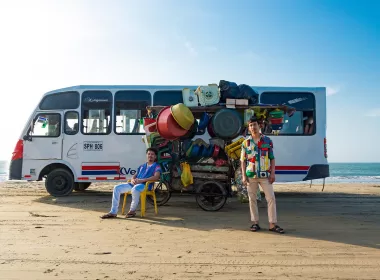In 2015, Justdiggit was a small NGO that had just received funding for a landscape restoration project at the Kuku Group Ranch in Kajiado, Kenya. Hillary Rotich, a Landscape Manager at Justdiggit, was tasked with assessing the landscape and the community to implement a solution for restoration. “When traveling through the degraded rangelands, the physical characteristics reminded me of landscapes in West Africa, where I knew through earlier work that they successfully implemented water bunds to restore these landscapes”, says Rotich.
Water or soil bunds, also referred to as half moons or earth smiles, are a land management technique in which semi-circular shapes are dug into the soil to capture rainwater and reduce runoff. Capturing rainwater allows for increased water infiltration and availability in the soil. Restoring soil moisture levels promotes the growth of native vegetation while also contributing to groundwater recharge and mitigating the effects of drought. Implementing soil bunds reduces soil erosion, prevents the loss of topsoil, helps retain nutrients, and improves soil fertility.
Each soil bund also has the potential to create microclimate habitats, supporting a variety of plant species, including annuals and perennials. This is often supplemented by sowing seeds in the bunds to grow more vegetation, resulting in a restored, green landscape and enhanced land productivity.
On the Kuku Group Ranch, around 40 soil bunds were initially dug to observe their ability to capture rainwater and withstand the sloping landscapes. After performing well, the bunds were implemented on a larger scale. “It was quite a nail-biting period as we did not have any long-term proof on the bunds [at the time], but the grant money had to be spent by the end of the year,” says Rotich. “So after that small pilot, we dug over 70,000 of them. Luckily, they did very well, and almost all of them are still there!”
Landscape restoration is typically a long-term process, spanning years to decades, that requires an ongoing commitment to monitoring and adaptive management. The ultimate goal is to create multifunctional landscapes that provide wildlife habitats, enhanced soil health, improved water availability, and carbon sequestration, contributing to improving the quality of life for people in the area. Restored landscapes are designed to be resilient to environmental change, including resilience to disturbances such as wildfires, floods, and invasive species.
Successful land management projects require the collaboration of local communities, government agencies, NGOs, and researchers. Integrating traditional ecological knowledge from indigenous and local communities is especially important in promoting cultural resilience in landscape integration practices. “It’s a complex process that requires collaboration, innovation, and ongoing commitment from all stakeholders involved,” says Rotich.
It’s a complex process that requires collaboration, innovation, and ongoing commitment from all stakeholders involved.
Justdiggit takes care to ensure that soil bund projects are community-owned and locally led. The organization goes beyond fostering partnerships with local organizations, institutions, and networks, implementing a training process designed to empower local farmers with the knowledge and resources for active participation in landscape restoration efforts.
To ensure that land restoration projects continue to grow and evolve with the communities, Justdiggit assesses the unique needs, priorities, and existing knowledge by meeting with community members and leaders. The organization provides education on landscape restoration, soil conservation, and water management while offering technical skill development and the necessary tools for soil bund construction. Over time, training programs are continuously monitored to assess the progress and impact on local communities, making adjustments as needed. Taking an adaptive management approach, feedback is solicited from community members to identify successes, challenges, and areas for improvement to reflect their needs.
Actively engaging communities throughout the soil bunds projects also fosters a sense of responsibility and accountability for participants, promoting transparency and trust among local leaders and community members. Taking a community-centric approach prioritizes the knowledge, perspectives, and priorities from local areas to provide valuable insights for project design and implementation. Justdiggit also involves community members in decision-making processes, empowering them to take control of their development and seize opportunities to create solutions and address challenges on their terms.
Justdiggit’s half-moon soil bunds promote the regreening and restoration of landscapes, prioritizing resilience for long-term impact. What makes these projects so effective is the consideration given to local communities. The soil bunds exemplify how integrating community empowerment and knowledge strengthens the case for building resilience.











